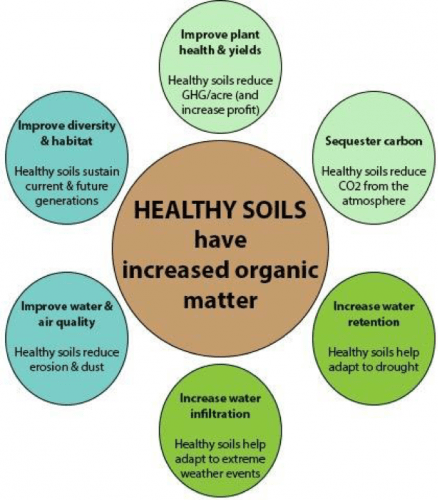Resources » Soil Health & Greenhouse Gasses
Healthy Soils for a Sustainable Future
Soils are fundamental to a secure future. With limited agricultural land and a changing climate, it is critical that we maintain our soils to ensure a resilient future for all.
Ways Soil Health Practices Can Mitigate Climate Change
-
- Increasing vegetative cover with double crops, cover crops, and perennial crops can help mitigate climate change by sequestering more carbon in soils while also improving productivity, reducing erosion, improving water quality, and improving soil health.
-
- Improving nitrogen fertilizer management (rate, timing, form, placement, precision agriculture) can help mitigate climate change by reducing nitrous oxide emissions while also improving profitability, water quality, and air quality.
-
- Improving manure management can help mitigate climate change by reducing emissions of methane and nitrous oxide and reducing emissions from fertilizer manufacturing, while also improving water quality, air quality, and soil health.
-
- Planting trees or reforesting marginal lands can help mitigate climate change by sequestering more carbon in soils and woody biomass while also reducing water and wind erosion, improving water quality, and improving soil health.
-
- Reducing tillage can improve soil health, reduce erosion, and improve water quality. These activities combined with appropriate return of crop residue or increased vegetation cover may help mitigate climate change by sequestering more carbon in soils but only if practiced over many years.
-
- Adding biochar to soils can help mitigate climate change by sequestering more carbon in soils while also improving water quality.
-
- Improving pasture and grazing management can help mitigate climate change by sequestering more carbon in soils while also improving productivity, reducing erosion, improving water quality, and improving soil health.
Some Challenges
While sequestering carbon in the landscape is good for multiple reasons, there are three key concerns about relying on soil carbon to verifiably and permanently mitigate GHG emissions:
1. Increasing soil carbon may also appreciably increase soil nitrogen, which can result in greater nitrous oxide (N2O) emissions. Nitrous oxide is ~300 times more potent as a GHG than CO2, so a small amount of increased N2O emission can negate a large amount of C-sequestration.
2. It can take decades to maximize soil carbon sequestration but just a year or two to lose it by disruption through tillage, erosion or other soil disturbance.
3. Quantifying and verifying the GHG benefits from soil health practices can be challenging and expensive.
